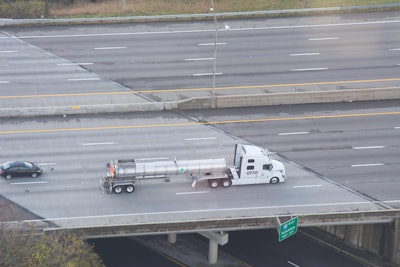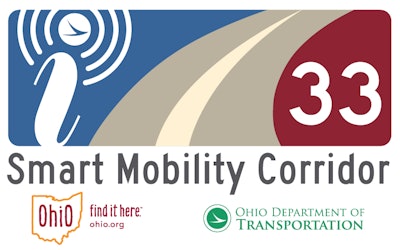 Autonomous vehicle tech developer Otto operates a truck on Ohio’s U.S. 33 Smart Mobility Corridor following an event announcing the roadway’s designation. Photo credit: Ohio Department of Transportation
Autonomous vehicle tech developer Otto operates a truck on Ohio’s U.S. 33 Smart Mobility Corridor following an event announcing the roadway’s designation. Photo credit: Ohio Department of TransportationOhio is turning 35 miles of U.S. 33 near Dublin into a Smart Mobility Corridor, along which the Ohio Department of Transportation is installing $15 million in highway technology features to test autonomous and connected vehicle features.
 Ohio Gov. John Kasich inside an autonomous truck powered by Otto to be tested on the Smart Mobility Corridor. (Photo: ODOT)
Ohio Gov. John Kasich inside an autonomous truck powered by Otto to be tested on the Smart Mobility Corridor. (Photo: ODOT)“Some of the world’s foremost automotive researchers are working here in Ohio, at both ends of this corridor, and this project provides them with the perfect location and state-of-the-art infrastructure for safely testing autonomous and connected vehicle technologies,” Gov. John Kasich says. “Ohio has been at the heart of automotive manufacturing and innovation since the industry’s earliest days. Those ties strengthen with each passing year and innovations developed here will continue to build on our state’s historic role as a world leader in transportation technology.”
Beginning in May, ODOT will add sensors and fiber optic cable along the corridor for communication links to researchers and traffic monitors from sensors placed along the highway to help in developing smart transportation technologies.
This stretch of highway carries roughly 50,000 vehicles per day and covers both rural and urban environments. The data collected, ODOT says, will help improve traffic counts, weather and surface condition monitoring and incident management procedures.

Partners on the project include Honda R&D Americas, the Transportation Research Center at East Liberty and The Ohio State University’s Center for Automotive Research, the City of Dublin, City of Marysville and Union.
“The Smart Mobility Corridor will also align with work underway to develop the City of Columbus as a hub for intelligent transportation, spurred by a $40 million “Smart City” grant from the U.S. Department of Transportation and more than $90 million committed to date by private-sector partners,” ODOT adds.












